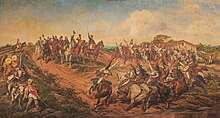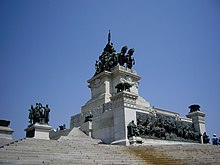Parque da Independência
The Parque da Independencia (Independence Park) is a park in the district of Ipiranga in São Paulo , Brazil with a total area of 184,830 m 2 .
history
Here, on the river Riacho do Ipiranga , Emperor Pedro I is said to have proclaimed Brazil's independence from the Portuguese motherland on September 7, 1822 ("Grito do Ipiranga").
This scene is captured in the famous painting “Independência ou Morte” by the painter Pedro Américo from 1888, which is exhibited in the state room of the Museu Paulista. The place is not accidental, as it was the area of the former country residence of Colonel João de Castro do Canto e Mello, the father of the Marquesa de Santos , the emperor's lover.
Just a few months after the declaration of independence, the idea arose to erect a monument to commemorate independence at the historic site. José Bonifácio , a confidante of the emperor, launched a public tender in 1823 with the aim of collecting the funds necessary to build the monument. In 1825 the city council recorded the exact location of the "grito do Ipiranga" so that the desired monument could be erected there. But it stayed that way for a long time. Again and again visitors to the mythical place were indignant that no reference was made to the historical events that had taken place here; not even the visit of Emperor Pedro II in 1846 was able to accelerate the implementation.
When the Portuguese writer Augusto Emílio Zaluar visited the place in 1869, he wrote:
“Anyone who leaves São Paulo on the road to Santos, after having passed the picturesque Glória, which is known for a house that can be seen off the road, and for the echo, which is particularly impressive there on beautiful moonlit nights, will follow a little more than a mile as the first sight to find a sterile, lonely and deserted place, where just a few grasses and stunted bushes grow, between which a dreary trickle meanders, and where loneliness and silence reign. This place is called campina do Ipiranga! There is not a monument, no column, no stone, not even at least a plaque, which draws the attention of passers-by to the fact that he is on the scene where the greatest event in the history of the country took place and where it is immortal day of independence of a people immortalized. "
Due to a lack of funds and a lack of consensus, the project was only completed in 1890 with the inauguration of the Museu Paulista.
Attractions
The Parque da Independência has four attractions:
The Museu Paulista, also called Museu do Ipiranga
The Museu Paulista was planned as a monument to the independence of Brazil by the Italian engineer Tommaso Gaudenzio Bezzi , whose design in 1881 was accepted by the provincial government three years later, and built between 1885 and 1889 by the Italian architect Luigi Pucci . The building is a palace in the neoclassical ( eclectic ) style, which is designed according to the simplified ideal model of a Renaissance palace. An elegant central building with porticos and two large side wings characterize the building. The total length of the facade is 123 meters. The completed construction does not correspond to the original model exhibited in the museum. This provided for an additional closure wing on each side.
It can be assumed that practically the entire construction team must have consisted of Italians (who were involved in many other major projects in São Paulo at the time), since the Brazilians, who at the time were still building using traditional reed technology, probably did not have enough skilled workers to carry them out such a monumental stone building could have contracted.
In 1889 the construction was declared finished, although the outside staircase and the entrance hall had not yet been completed because the necessary materials had not arrived from Italy on time. These will be completed a little later.
With a fund of 125,000 objects, the museum shows an ethnographic and historical exhibition about Brazil and in particular a section on the history of São Paulo, which has a model of the city from 1841, among other things. The museum belongs to the University of São Paulo and is very active as a research and teaching company. The original cornerstone of the collection is the inventory of the former Muséu Sertório, which belonged to Colonel Joaquim Sertório and was acquired by Francisco de Paula Mayrinck in 1890 as a gift to the State of São Paulo. The Museu Paulista as an institution was established by law in 1893 and the Sertório collection was then moved to the Museum Palace in 1894.
The grand opening of the Museu Paulista took place on September 7, 1895.
Over the years, the palace building was given further decorative elements. In particular, two large statues of the bandeirantes António Raposo Tavares and Fernão Dias Paes by the Italian sculptor Luigi Brizzolara were erected.
The gardens
The gardens directly in front of the Museu Paulista are modeled - to a limited extent - on the gardens of Versailles .
Its design was commissioned in 1907 by the then Minister of Agriculture, the doctor Carlos Botelho , from the Belgian landscape designer Arsenius Puttemans , who realized it between 1908 and 1909.
On the occasion of the 100th anniversary of independence, the gardens were considerably expanded by a further 1,500 m 2 in 1922 .
Since the extensive renovation of the facilities in 2004, the whole splendor of the water features and green spaces has been fully unfolding again.
The Casa do Grito
In the lower part of the garden there is a building made of old reed construction. Allegedly this is supposed to be the building that can be seen in Pedro Américo's painting “Independência ou Morte”. The scholars argue about this, however. The fact is that the building is documented only mentioned in 1884. The house has been a listed building since 1975.
The Monument of Independence
In the lower part of the park is the huge Independence Monument . The monumental ensemble, inaugurated in 1922 on the occasion of the 100th anniversary of independence and completed in 1926, was designed by the Italian sculptor Ettore Ximenes and shows various great minds of Brazilian independence. Inside are the tombs of the Brazilian Emperor Dom Pedro I and his two wives Leopoldina and Amélie .


